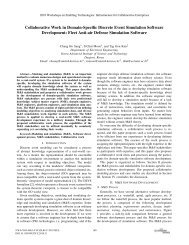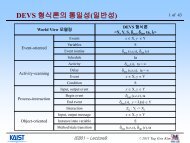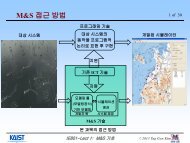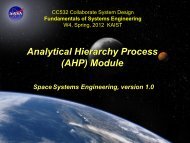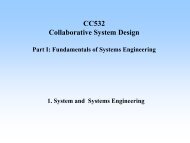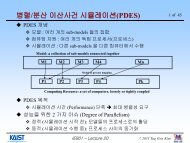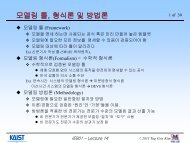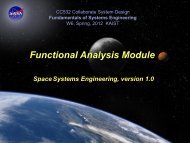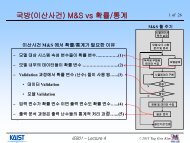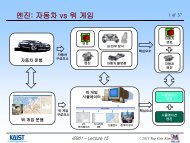System Hierarchy - Systems Modeling Simulation Lab. KAIST
System Hierarchy - Systems Modeling Simulation Lab. KAIST
System Hierarchy - Systems Modeling Simulation Lab. KAIST
Create successful ePaper yourself
Turn your PDF publications into a flip-book with our unique Google optimized e-Paper software.
CC532 Collaborate <strong>System</strong> Design<br />
Fundamentals of <strong>System</strong>s Engineering<br />
W4, Spring, 2012 <strong>KAIST</strong><br />
<strong>System</strong> <strong>Hierarchy</strong> and<br />
Work Breakdown Structure Module<br />
Space <strong>System</strong>s Engineering, version 1.0<br />
Space <strong>System</strong>s Engineering: <strong>System</strong> <strong>Hierarchy</strong> Module
Module Purpose: <strong>System</strong> <strong>Hierarchy</strong><br />
To show how one view of the system architecture is captured<br />
by the product breakdown structure (PBS).<br />
To describe the benefits and costs of creating a system<br />
hierarchy.<br />
To show how to capture all of the work necessary for a project<br />
by adding the non-product work to the PBS to create the work<br />
breakdown structure (WBS).<br />
Space <strong>System</strong>s Engineering: <strong>System</strong> <strong>Hierarchy</strong> Module 2
One View of the Architecture - The<br />
Product Breakdown Structure<br />
The framework and interrelationships of elements<br />
of a system. Typically illustrated by both a<br />
pictorial and a decomposition diagram depicting<br />
the segments and elements and their interfaces<br />
and interrelationships.<br />
Architecture is<br />
described by the<br />
<strong>System</strong> <strong>Hierarchy</strong> or<br />
Product Breakdown<br />
Structure (PBS)<br />
Space <strong>System</strong>s Engineering: <strong>System</strong> <strong>Hierarchy</strong> Module 3
Why Break a Product Down<br />
Breaking a large complex problem (project) into smaller pieces makes them<br />
easier to solve since the problems are smaller and specialists can focus<br />
on their functional areas.<br />
But this process of reductionism creates some new problems. Namely,<br />
<br />
<br />
<br />
New interfaces are created between the pieces (subsystems), so they<br />
must be defined and managed.<br />
<strong>System</strong> resources (e.g., mass or power) must be allocated to the<br />
subsystems and these allocations must be accounted for; and<br />
<strong>System</strong> performance is also allocated to subsystems, so confidence<br />
must be established that if all of the subsystems perform as desired,<br />
then the system will perform as desired.<br />
The creation of the system architecture, the description and management of<br />
interfaces, the allocation of resources and performances, and<br />
establishing confidence that these allocations are appropriate are all<br />
systems engineering responsibilities.<br />
Space <strong>System</strong>s Engineering: <strong>System</strong> <strong>Hierarchy</strong> Module 4
More Value to Creating<br />
A <strong>System</strong> <strong>Hierarchy</strong><br />
Organizes the work required<br />
to complete a flight project.<br />
Contains all hardware items,<br />
software items, and<br />
information items (e.g.,<br />
documents, databases).<br />
Provides the basis for<br />
functional analysis.<br />
Characteristics:<br />
• Top-down,<br />
• Product-based,<br />
• Lowest level maps to<br />
cognizant engineer or<br />
manager,<br />
• Branch points in hierarchy<br />
show how elements will be<br />
integrated.<br />
Space <strong>System</strong>s Engineering: <strong>System</strong> <strong>Hierarchy</strong> Module 5
Hierarchical Level Names and Examples<br />
Hierarchical Level Name<br />
Mission<br />
<strong>System</strong>*<br />
Examples<br />
Needs + Objectives + Operation of Everything Necessary to Meet the Objectives<br />
Total <strong>System</strong> = Spacecraft + Lau nch Vehicle + Ground Support Equipmen t + Communications<br />
<strong>System</strong>s (TDRSS, etc.) + NASCOM + POC + Science Data Center + ...+ Personnel<br />
Segment Flight = Spacecraft Bus + Instrume nts + Launch Vehicle +...<br />
Element Spacecraft = Structure + Powe r + C&DH + Thermal + ...<br />
Subs ystem Power = Solar Arrays + Electronics + Battery + Fuses + ...<br />
Component Solar Arrays = Solar Cells + Interconnects + Cover Glass + ...<br />
Part<br />
Solar Cells<br />
* Any given system can be organized into a hierarchy composed of segments and/or<br />
elements of succeedingly lower and less complex levels, which may in themselves be<br />
termed “systems” by their designers. In order to avoid misunderstandings, hierarchical<br />
levels for a given mission must be defined early.<br />
Space <strong>System</strong>s Engineering: <strong>System</strong> <strong>Hierarchy</strong> Module 6
<strong>System</strong> <strong>Hierarchy</strong> (1/2)<br />
<br />
<strong>Hierarchy</strong>/Hierarchical Levels - The relationship of one item of<br />
hardware/software with respect to items above and below in the<br />
relative order of things.<br />
<br />
<br />
Mission - An individual system or groups of systems operated to<br />
meet a specific set of objectives.<br />
<strong>System</strong> - A composite of hardware, software, skills, personnel,<br />
and techniques capable of performing and/or supporting an<br />
operational role. A complete system includes related facilities,<br />
equipment, materials, services, software, technical data, and<br />
personnel required for its operation and support to the degree<br />
that it can be considered a self-sufficient unit in its intended<br />
operational and/or support environment.<br />
• The system is what is employed operationally and supported<br />
logistically. (More than one system may be needed to conduct a<br />
mission.)<br />
Space <strong>System</strong>s Engineering: <strong>System</strong> <strong>Hierarchy</strong> Module 7
<strong>System</strong> <strong>Hierarchy</strong> (2/2)<br />
<br />
<br />
<br />
<br />
<br />
Segment - A grouping of elements that are closely related and<br />
which often physically interface. It may consist of elements<br />
produced by several organizations and integrated by one.<br />
Element - A complete, integrated set of subsystems capable of<br />
accomplishing an operational role or function.<br />
Subsystem - A functional grouping of components that combine<br />
to perform a major function within an element.<br />
Component - A functional subdivision of a subsystem and<br />
generally a self-contained combination of items performing a<br />
function necessary for subsystem operation. A functional unit<br />
viewed as an entity for purpose of analysis, manufacturing,<br />
testing, or record keeping.<br />
Part - A hardware element that is not normally subject to further<br />
subdivision or disassembly without destruction of designated use.<br />
Space <strong>System</strong>s Engineering: <strong>System</strong> <strong>Hierarchy</strong> Module 8
<strong>System</strong> <strong>Hierarchy</strong> Example - Space Shuttle<br />
<strong>System</strong><br />
Segment<br />
Element<br />
Subsystem<br />
<strong>System</strong> hierarchy is also referred to as the Product Breakdown Structure (PBS).<br />
Space <strong>System</strong>s Engineering: <strong>System</strong> <strong>Hierarchy</strong> Module 9
How complicated it can get…<br />
The yellow boxes represent the bottom-level end products.<br />
Space <strong>System</strong>s Engineering: <strong>System</strong> <strong>Hierarchy</strong> Module 10
Definition<br />
Work Breakdown Structure (WBS)<br />
A hierarchical breakdown of the work necessary to complete a<br />
project. The WBS should be a product-based, hierarchical<br />
division of deliverable items and associated services.<br />
The WBS is based on the <strong>System</strong> <strong>Hierarchy</strong> or Product<br />
Breakdown Structure (PBS), with the specified prime products<br />
at the top, and the systems, segments, subsystems, etc. at<br />
successive lower levels.<br />
At the lowest level are products, such as hardware and<br />
software for which there is a cognizant engineer or manager.<br />
The WBS is built from the PBS by adding (at each level) the<br />
necessary service elements, such as management, systems<br />
engineering, integration and verification, and logistics support.<br />
Space <strong>System</strong>s Engineering: <strong>System</strong> <strong>Hierarchy</strong> Module 11
Relationship Between PBS and WBS<br />
<strong>System</strong><br />
Subsystem A Subsystem B Subsystem C Management <strong>System</strong>s<br />
Engineering<br />
Integration,<br />
Test & Verification<br />
Logistics<br />
Support<br />
PBS<br />
The Product Breakdown<br />
Structure shows the<br />
components from which<br />
the system was formed.<br />
The PBS reflects the<br />
work to produce<br />
the individual<br />
system components.<br />
The Work Breakdown<br />
Structure shows all<br />
work components necessary<br />
to produce a complete<br />
system.<br />
The WBS reflects the<br />
work to integrate<br />
the components<br />
into a system.<br />
WBS<br />
Space <strong>System</strong>s Engineering: <strong>System</strong> <strong>Hierarchy</strong> Module 12
Work Breakdown Structure (WBS)<br />
<br />
<br />
<br />
A Work Breakdown <strong>System</strong> (WBS) is used for:<br />
• Task or work package planning and scheduling<br />
• Cost estimating or budget formulation<br />
• Product development documentation, e.g., documentation<br />
tree, systems engineering management plan (SEMP),<br />
drawings<br />
• Project status reporting and assessment<br />
The WBS should include:<br />
• All the work in the project life cycle, in-house and/or<br />
contracted<br />
• Hierarchical relationships of all work products<br />
• A companion dictionary to describe the content<br />
When should you have a WBS<br />
• Pre-phase A; conceptual design phase; early mission/project<br />
formulation<br />
Space <strong>System</strong>s Engineering: <strong>System</strong> <strong>Hierarchy</strong> Module 13
NASA Standard WBS at Level 2<br />
Flight Dev elopment<br />
Space Flight<br />
And Operations<br />
Project<br />
Project<br />
Project<br />
Management<br />
01<br />
Sy stems<br />
Engineering<br />
02<br />
Saf ety & Mission<br />
Assurance<br />
03<br />
Science /<br />
Technology<br />
04<br />
Pay load(s)<br />
05<br />
Spacecr<br />
Aircraf t /<br />
Spacecraf t<br />
aft06<br />
06<br />
Mission<br />
Operations<br />
07<br />
Launch Vehicle /<br />
Serv ices<br />
08<br />
Ground<br />
Sy stem(s)<br />
09<br />
Sy stems Integration<br />
& Testing<br />
10<br />
Education and<br />
Public Outreach<br />
11<br />
Standard Level 2 WBS Elements for Space Flight Projects<br />
Space <strong>System</strong>s Engineering: <strong>System</strong> <strong>Hierarchy</strong> Module 14
Example: NASA’s SOFIA Project PBS and WBS<br />
PBS<br />
Sofia Project<br />
Observatory <strong>System</strong><br />
Ground Support <strong>System</strong><br />
Airborne Facility<br />
Science Instruments<br />
<strong>Lab</strong>s/Offices Facility GSE Mission Planning Simulator<br />
Aircraft Element<br />
Telescope Element<br />
Telescope Subsystem<br />
Electronics Subsystem<br />
WBS<br />
Sofia Project<br />
Management<br />
<strong>System</strong>s<br />
Engineering<br />
Project<br />
Integration &<br />
Test<br />
Operations<br />
and Logistics<br />
Planning<br />
Science<br />
Support<br />
Mission<br />
Assurance<br />
Observatory<br />
<strong>System</strong><br />
Ground<br />
Support<br />
<strong>System</strong><br />
Space <strong>System</strong>s Engineering: <strong>System</strong> <strong>Hierarchy</strong> Module 15
Pause and Learn Opportunity<br />
View the James Webb Space Telescope (JWST) WBS<br />
& Dictionary Baseline document for example<br />
implementation.<br />
(JWST WBS & Dictionary (Baseline).pdf)<br />
Space <strong>System</strong>s Engineering: <strong>System</strong> <strong>Hierarchy</strong> Module
Techniques for Developing a WBS<br />
<br />
<br />
<br />
<br />
<br />
<br />
<br />
Takes several iterations through the life of the project, since the full<br />
extent of the work is not obvious at the outset.<br />
Develop <strong>System</strong> <strong>Hierarchy</strong> / PBS first, from the top down<br />
Develop WBS by adding appropriate services, such as management<br />
and systems engineering to the lower levels<br />
Use a similar structure as a starting point for all product elements of<br />
the WBS at all levels<br />
Repeat for all levels, starting with project level<br />
Involve people who will be responsible for the lower level WBS<br />
elements.<br />
Document assumptions, e.g., common spacecraft computer and<br />
software; all operations development costs under mission ops;<br />
testbeds and prototype hardware contained within hardware<br />
element etc.<br />
Space <strong>System</strong>s Engineering: <strong>System</strong> <strong>Hierarchy</strong> Module 17
Module Summary: <strong>System</strong> <strong>Hierarchy</strong><br />
A product breakdown structure (PBS) captures the hierarchy of<br />
the system and is one representation of the system architecture.<br />
Creating a system hierarchy is valuable since it breaks a<br />
complex problem into smaller pieces that will be easier to tackle.<br />
But this reductionism, or decomposition has a price:<br />
• New interfaces are created between the pieces (subsystems), so<br />
they must be defined and managed.<br />
• <strong>System</strong> resources (e.g., mass or power) must allocated to the<br />
subsystems and these allocations must be accounted for; and<br />
• <strong>System</strong> performance is also allocated to subsystems, so<br />
confidence must be established that if all of the subsystems<br />
perform as desired that the system will perform as desired.<br />
The work breakdown structure (WBS) extends the PBS in that it<br />
captures all of the work necessary for a project by adding the<br />
non-product work necessary for a successful project (e.g.,<br />
integration, test, logistics support, systems engineering and<br />
management).<br />
Space <strong>System</strong>s Engineering: <strong>System</strong> <strong>Hierarchy</strong> Module 18
Backup Slides<br />
for <strong>System</strong> <strong>Hierarchy</strong> Module<br />
Note slides 26-28 demonstrate some common errors in<br />
PBS and WBS structure. The pilot students found<br />
these useful, so they could be included in the body of<br />
the lecture.<br />
Space <strong>System</strong>s Engineering: <strong>System</strong> <strong>Hierarchy</strong> Module
NASA Space Flight Project<br />
Standard WBS Dictionary (1/4)<br />
<br />
<br />
<br />
Element 1 – Project Management: The business and administrative planning, organizing,<br />
directing, coordinating, analyzing, controlling, and approval processes used to accomplish<br />
overall project objectives, which are not associated with specific hardware or software<br />
elements. This element includes project reviews and documentation, non-project owned<br />
facilities, and project reserves. It excludes costs associated with technical planning and<br />
management and costs associated with delivering specific engineering, hardware and<br />
software products.<br />
Element 2 – <strong>System</strong>s Engineering: The technical and management efforts of directing and<br />
controlling an integrated engineering effort for the project. This element includes the<br />
efforts to define the project space flight vehicle(s) and ground system, conducting trade<br />
studies, the integrated planning and control of the technical program efforts of design<br />
engineering, software engineering, specialty engineering, system architecture development<br />
and integrated test planning, system requirements writing, configuration control, technical<br />
oversight, control and monitoring of the technical program, and risk management activities.<br />
Documentation products include requirements documents, interface control documents<br />
(ICDs), Risk Management Plan, and master verification and validation (V&V) plan.<br />
Excludes any design engineering costs.<br />
Element 3 – Safety and Mission Assurance: The technical and management efforts of<br />
directing and controlling the safety and mission assurance elements of the project. This<br />
element includes design, development, review, and verification of practices and procedures<br />
and mission success criteria intended to assure that the delivered spacecraft, ground<br />
systems, mission operations, and payload(s) meet performance requirements and function<br />
for their intended lifetimes. This element excludes mission and product assurance efforts<br />
directed at partners and subcontractors other than a review/oversight function, and the<br />
direct costs of environmental testing.<br />
Space <strong>System</strong>s Engineering: <strong>System</strong> <strong>Hierarchy</strong> Module 20
NASA Space Flight Project<br />
Standard WBS Dictionary (2/4)<br />
<br />
<br />
<br />
Element 4 – Science / Technology: This element includes the managing, directing, and<br />
controlling of the science investigation aspects, as well as leading, managing, and<br />
performing the technology demonstration elements of the Project. The costs incurred to<br />
cover the Principal Investigator, Project Scientist, science team members, and equivalent<br />
personnel for technology demonstrations are included. Specific responsibilities include<br />
defining the science or demonstration requirements; ensuring the integration of these<br />
requirements with the payloads, spacecraft, ground systems, and mission operations;<br />
providing the algorithms for data processing and analyses; and performing data analysis<br />
and archiving. This element excludes hardware and software for onboard science<br />
investigative instruments/payloads.<br />
Element 5 – Payload: This element includes the equipment provided for special purposes<br />
in addition to the normal equipment (i.e., GSE) integral to the spacecraft. This includes<br />
leading, managing, and implementing the hardware and software payloads that perform<br />
the scientific experimental and data gathering functions placed on board the spacecraft, as<br />
well as the technology demonstration for the mission.<br />
Element 6 – Spacecraft(s): The spacecraft that serves as the platform for carrying payload(s),<br />
instrument(s), humans, and other mission-oriented equipment in space to the mission<br />
destination(s) to achieve the mission objectives. The spacecraft may be a single spacecraft<br />
or multiple spacecraft/modules (i.e., cruise stage, orbiter, lander, or rover modules). Each<br />
spacecraft/module of the system includes the following subsystems, as appropriate: Crew,<br />
Power, Command & Data Handling, Telecommunications, Mechanical, Thermal,<br />
Propulsion, Guidance Navigation and Control, Wiring Harness, and Flight Software. This<br />
element also includes all design, development, production, assembly, test efforts, and<br />
associated GSE to deliver the completed system for integration with the launch vehicle and<br />
payload. This element does not include integration and test with payloads and other<br />
project systems.<br />
Space <strong>System</strong>s Engineering: <strong>System</strong> <strong>Hierarchy</strong> Module 21
NASA Space Flight Project<br />
Standard WBS Dictionary (3/4)<br />
<br />
<br />
Element 7 - Mission Operations <strong>System</strong>: The management of the development and<br />
implementation of personnel, procedures, documentation, and training required to conduct<br />
mission operations. This element includes tracking, commanding, receiving/processing<br />
telemetry, analyses of system status, trajectory analysis, orbit determination, maneuver<br />
analysis, target body orbit/ephemeris updates, and disposal of remaining end-of-mission<br />
resources. The same WBS structure is used for Phase E Mission Operation <strong>System</strong>s but with<br />
inactive elements defined as “not applicable.” However, different accounts must be used<br />
for Phase E due to NASA cost reporting requirements. This element does not include<br />
integration and test with the other project systems.<br />
Element 8 – Launch Vehicle / Services: The management and implementation of activities<br />
required to place the spacecraft directly into its operational environment, or on a trajectory<br />
towards its intended target. This element includes launch vehicle, launch vehicle<br />
integration, launch operations, any other associated launch services (frequently includes an<br />
upper-stage propulsion system), and associated ground support equipment. This element<br />
does not include the integration and test with the other project systems.<br />
Space <strong>System</strong>s Engineering: <strong>System</strong> <strong>Hierarchy</strong> Module 22
NASA Space Flight Project<br />
Standard WBS Dictionary (4/4)<br />
<br />
<br />
<br />
Element 9 – Ground <strong>System</strong>(s): The complex of equipment, hardware, software, networks,<br />
and mission-unique facilities required to conduct mission operations of the spacecraft<br />
systems and payloads. This complex includes the computers, communications, operating<br />
systems, and networking equipment needed to interconnect and host the Mission<br />
Operations software. This element includes the design, development, implementation,<br />
integration, test, and the associated support equipment of the ground system, including the<br />
hardware and software needed for processing, archiving, and distributing telemetry and<br />
radiometric data and for commanding the spacecraft. Also includes the use and<br />
maintenance of the project testbeds and project-owned facilities. This element does not<br />
include integration and test with the other project systems and conducting mission<br />
operations.<br />
Element 10 – <strong>System</strong>s Integration and Testing: This element includes the hardware,<br />
software, procedures, and project-owned facilities required to perform the integration and<br />
testing of the project’s systems, payloads, spacecraft, launch vehicle/services, and mission<br />
operations.<br />
Element 11 – Education and Public Outreach: Provide for the education and public<br />
outreach (EPO) responsibilities of NASA’s missions, projects, and programs in alignment<br />
with the Strategic Plan for Education. Includes management and coordinated activities,<br />
formal education, informal education, public outreach, media support, and website<br />
development.<br />
Space <strong>System</strong>s Engineering: <strong>System</strong> <strong>Hierarchy</strong> Module 23
WBS Levels<br />
Standard WBS for a JPL Mission<br />
1<br />
Project Name<br />
2<br />
Project Management<br />
01<br />
Project Sys Eng<br />
02<br />
Mission Assurance<br />
03<br />
Science<br />
04<br />
Payload<br />
05<br />
Flight <strong>System</strong><br />
06<br />
Mission Ops <strong>System</strong><br />
07<br />
Launch <strong>System</strong><br />
08<br />
3<br />
Project Mgmnt<br />
01.01<br />
Project Sys Eng<br />
02.01<br />
MA Mgmnt<br />
03.01<br />
Science Mgmnt<br />
04.01<br />
P/L Mgmnt<br />
05.01<br />
Spacecraft Contract<br />
06.00<br />
Mission Ops Mgmnt<br />
07.01<br />
Launch Services<br />
08.01<br />
Business Mgmnt<br />
01.02<br />
Mission & Nav Design<br />
02.02<br />
<strong>System</strong> Safety<br />
03.02<br />
Science Team<br />
04.02<br />
P/L Sys Eng<br />
05.02<br />
Flt Sys Mgmnt<br />
06.01<br />
MOS Sys Eng<br />
07.02<br />
Risk Mgmnt<br />
01.03<br />
Project SW Eng<br />
02.03<br />
Environments<br />
03.03<br />
Sci Data Support<br />
04.03<br />
Instrument 1<br />
05.03<br />
Flt Sys - Sys Eng<br />
06.02<br />
Ground Data Sys<br />
07.03<br />
Project Plng Spt<br />
01.04<br />
Information <strong>System</strong>s<br />
02.04<br />
Reliability<br />
03.04<br />
Sci Investigatio<br />
& Ops Spt<br />
04.04<br />
Instrument N<br />
05.04<br />
Power Subsys<br />
06.03<br />
Operations<br />
07.04<br />
Review Support<br />
01.05<br />
Config Mgmnt<br />
02.05<br />
EEE Parts Eng<br />
03.05<br />
Sci Environment<br />
Characterization<br />
04.05<br />
Common P/L <strong>System</strong>s<br />
05.05<br />
Command & Data S/s<br />
06.04<br />
MOS V&V<br />
07.05<br />
Facilities<br />
01.06<br />
Planetary Protection<br />
02.06<br />
HW Q&A<br />
03.06<br />
Education & Outreach<br />
04.06<br />
P/L I&T<br />
05.06<br />
Telecomm Subsys<br />
06.05<br />
Foreign Travel/ITAR<br />
01.07<br />
Launch Sys Eng<br />
02.07<br />
SW Q&A<br />
03.07<br />
Mechanical Subsys<br />
06.06<br />
Project V&V<br />
02.08<br />
Contamination Control<br />
03.08<br />
Thermal Subsys<br />
06.07<br />
SW IV&V<br />
03.09<br />
Propulsion Subsys<br />
06.08<br />
GN&C Subsys<br />
06.09<br />
Spacecraft Flt SW<br />
06.10<br />
Testbeds<br />
06.11<br />
Spacecraft assembly<br />
test & verification<br />
06.12<br />
Space <strong>System</strong>s Engineering: <strong>System</strong> <strong>Hierarchy</strong> Module 24
Rules for the NASA Standard WBS<br />
1. The Project Name will be WBS Level 1.<br />
2. The title of each WBS Level 2 element can be modified to facilitate project-unique<br />
titles, but the content of each must remain the same. If the linkage of the projectunique<br />
title to the standard title is not intuitive, the project-unique title is crossreferenced<br />
to the standard.<br />
3. If the set of standard WBS Level 2 elements does not comprise an exhaustive set of<br />
WBS elements, additional WBS elements may be added horizontally (i.e., at Level 2)<br />
as long as their content does not fit into the content of any existing standard WBS<br />
elements.<br />
4. For each standard WBS Level 2 element, the subordinate (children) WBS elements<br />
at Level 3 and lower will be determined by the project.<br />
5. The Level 3 and lower elements can differ from project to project but will include<br />
only work that rolls up to the standard WBS Dictionary definition of the Level 2<br />
element. (See back-up for definitions.)<br />
6. If there is no work to fit into a standard WBS element, then an inactive placeholder<br />
element (and an inactive placeholder financial code) will be established.<br />
7. A single WBS will be used for both technical/business management and reporting.<br />
8. The management assigned to each WBS element may differ from project to project.<br />
Space <strong>System</strong>s Engineering: <strong>System</strong> <strong>Hierarchy</strong> Module 25
Common WBS Errors (1/3)<br />
Error 1: Functions without products.<br />
•The WBS describes functions not products.<br />
•This makes the project manager the only one formally<br />
responsible for products.<br />
Project<br />
Management Engineering Fabrication Verification<br />
Space <strong>System</strong>s Engineering: <strong>System</strong> <strong>Hierarchy</strong> Module 26
Common WBS Errors (2/3)<br />
Error 2: Inappropriate branches<br />
• The WBS has branch points that are not consistent with how<br />
the WBS elements will be integrated.<br />
• Inappropriate to separate hardware and software as if they are<br />
separate systems to be integrated at the system level.<br />
• This makes it difficult to assign accountability for integration<br />
and to identify the costs of integrating and testing components<br />
of a system.<br />
Distributed<br />
Information<br />
<strong>System</strong><br />
Software<br />
Hardware<br />
Space <strong>System</strong>s Engineering: <strong>System</strong> <strong>Hierarchy</strong> Module 27
Common WBS Errors (3/3)<br />
Error 3: Inconsistency with PBS<br />
• The WBS is inconsistent with the PBS.<br />
• This makes it possible that the PBS will not be fully<br />
implemented, and complicates the management process.<br />
Subsystem<br />
Subsystem<br />
Telescope<br />
Assembly<br />
Optics/Mirror<br />
XXX<br />
YYY<br />
Telescope<br />
Assembly<br />
ZZZ<br />
Optics/Mirror<br />
The Work Breakdown <strong>System</strong><br />
The Product Breakdown <strong>System</strong><br />
Space <strong>System</strong>s Engineering: <strong>System</strong> <strong>Hierarchy</strong> Module 28
Space <strong>System</strong>s Engineering: <strong>System</strong> <strong>Hierarchy</strong> Module<br />
Additional information for WBS module<br />
related to organizational structure
Relationship Between WBS and Organization<br />
<br />
<br />
<br />
Organizational structure for a program and/or project<br />
usually aligns with the WBS. Although the staffing of<br />
the functions can be addressed in a variety of ways<br />
based on the culture and size of the organization.<br />
Good reference on engineering organizational<br />
structures: “<strong>System</strong>s Engineering Management” by<br />
Benjamin Blanchard (chapter 7)<br />
• Matrix organization structure (section 7.3.3)<br />
• Producer organization (combined project-functional structure)<br />
(section 7.3.4)<br />
Examples:<br />
• Exploration <strong>System</strong>s (see next chart)<br />
Space <strong>System</strong>s Engineering: <strong>System</strong> <strong>Hierarchy</strong> Module 30
Organizational Structure for Exploration<br />
Level 1<br />
NASA Headquarters<br />
Exploration <strong>System</strong>s Mission Directorate<br />
Washington, DC<br />
Level 2<br />
Constellation Program Office<br />
Johnson Space Center (JSC)<br />
Houston, TX<br />
Level 3<br />
CEV/Orion Project Office<br />
JSC<br />
Houston, TX<br />
Ares 1 Launch Vehicle Project Office<br />
MSFC<br />
Huntsville, AL<br />
Launch <strong>System</strong>s Project Office<br />
KSC<br />
Florida<br />
Level 4<br />
Prime Contractor<br />
Lockheed-Martin<br />
National<br />
Non-Prime<br />
(in-house) work<br />
Subcontractor<br />
National<br />
Service Module<br />
GRC<br />
Ohio<br />
Launch Escape<br />
<strong>System</strong><br />
LaRC<br />
Virginia<br />
Suppliers<br />
National<br />
Example for NASA human spaceflight effort.<br />
Reflects derivation of authority from HQ to<br />
Program to Projects.<br />
Requirements flow in same top-down direction.<br />
Space <strong>System</strong>s Engineering: <strong>System</strong> <strong>Hierarchy</strong> Module 31
Organizational Structure of Level 2 Box<br />
Space <strong>System</strong>s Engineering: <strong>System</strong> <strong>Hierarchy</strong> Module 32
Constellation Program<br />
<strong>System</strong>s Engineering & Integration (SE&I)<br />
SE&I Offices, CxP Offices<br />
& Center SE&I Focals<br />
Horizontal Integration<br />
TBD/Tracy Hom<br />
ZF111<br />
SE&I Director<br />
Chris Hardcastle<br />
Deputies<br />
Charlie Lundquist-Transition & Integration<br />
David Petri – Planning & Performance<br />
Vertical Integration<br />
Burt Laws/<br />
Steve Meacham (M)/<br />
Renee Cox (M)<br />
Level I<br />
& Level 3 Projects<br />
PSE<br />
Office<br />
CxAT<br />
Technical Staff<br />
CoST/CxAT Focal - John Baker (M)<br />
Chief Architect: Bret Drake**<br />
Verification: John Kennedy<br />
SIP/Time Phased Capability: Keith Williams<br />
Avionics & SW: Jeff Stephenson<br />
CoS Organization Jason Weeks (A)<br />
Secretary-Tina Cobb (C)<br />
Secretary-LaNell Cobarruvias (C)<br />
SECB<br />
Steve Meacham (M) -Technical Mgr Integ. MSFC*<br />
Jerry Hill (M) - Ares 1-X SE&I Interface & SERP Rep<br />
Supportability/Operability/Affordability<br />
Kevin Watson/TBD<br />
Program Technical<br />
Integration<br />
Chief: Margarita Sampson<br />
Deputy: Nancy Srb<br />
Deputy: Kerri Knotts **<br />
PTI Forum<br />
ZF211<br />
SW & Avionics<br />
Integration Office<br />
Chief: Monte Goforth<br />
Deputy: Don Monell<br />
CSCP/M&SWG<br />
DSILWG<br />
ZF311 ZF411 ZF511<br />
Analysis, Trades &<br />
Process, Requirements<br />
Architecture<br />
& Interface Mgt Office<br />
Chief: Neil Lemmons<br />
Chief: Dave Forrest (A)<br />
Deputy: Deb Ludban (A)<br />
AWG<br />
Chief: Michele DiGiuseppe<br />
Deputy: Debbie Korth<br />
RICWG<br />
* = Technical Mgr for all MSFC Level II Program SEI activities in support of SE Office Chiefs.<br />
** = Post LAT 2 Team Assignment<br />
M = Matrixed<br />
A = Acting<br />
C = Contractor<br />
In these Numbers:<br />
Partial funding provided by NASA HQ &<br />
some Procurement S (converted to Eps here)<br />
ALL to be scrubbed as apart of Pending PPBE/ITA revision<br />
Space <strong>System</strong>s Engineering: <strong>System</strong> <strong>Hierarchy</strong> Module 33



